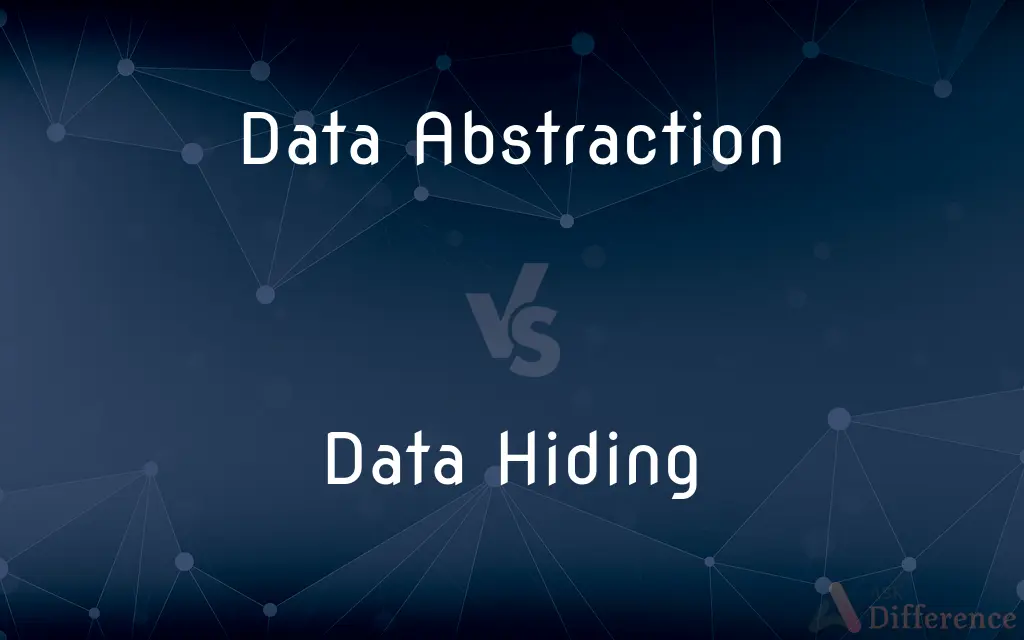Data Abstraction vs. Data Hiding — What's the Difference?
By Tayyaba Rehman & Urooj Arif — Published on February 8, 2024
Data Abstraction simplifies complexity by showing only necessary details, while Data Hiding conceals internal object details from outside users for security.

Difference Between Data Abstraction and Data Hiding
Table of Contents
ADVERTISEMENT
Key Differences
Data Abstraction in programming is the process of hiding complex realities while exposing only the necessary parts, making interactions simpler. Conversely, Data Hiding is a technique that ensures sensitive data within a class or module is not directly accessible from outside, thus securing the data.
The purpose of Data Abstraction is to reduce complexity for the user or programmer by abstracting away technical details. In contrast, Data Hiding focuses primarily on protecting data integrity and privacy by restricting access to internal object details.
Data Abstraction can be seen in high-level programming where details like memory management are abstracted. Data Hiding, on the other hand, is implemented through access specifiers like private and protected in object-oriented programming.
In Data Abstraction, the emphasis is on what an object does, rather than how it does it. Data Hiding, meanwhile, ensures that the internal workings of an object are hidden, preventing unauthorized manipulation.
An example of Data Abstraction is a user interface that simplifies complex processes. An example of Data Hiding is a class in a program that does not allow direct modification of its variables from outside its methods.
ADVERTISEMENT
Comparison Chart
Primary Purpose
Simplify complexity by showing only necessary parts.
Protect data integrity and privacy by restricting access.
Implementation in Programming
In high-level programming through abstraction layers.
Through access specifiers like private and protected.
Focus
On what an object does (external perspective).
On how an object works internally (internal perspective).
Benefit to User/Programmer
Reduces complexity and enhances usability.
Ensures security and prevents unauthorized access.
Common Example
User interfaces that hide complex processes.
Class variables that are not directly accessible.
Compare with Definitions
Data Abstraction
A method to reduce and simplify system interactions.
The ATM machine provides data abstraction from the banking processes.
Data Hiding
Concealing details of an object's internal state in programming.
Using private variables in a class is a practice of data hiding.
Data Abstraction
Conceptualizing complex data into more understandable forms.
Object-oriented programming uses classes as a form of data abstraction.
Data Hiding
Protecting data integrity by limiting exposure to the data.
A database system hides sensitive information through user access levels.
Data Abstraction
Simplifying complex systems by highlighting essential features.
The graphic interface is a form of data abstraction for the complex code.
Data Hiding
Restricting direct access to certain components of a program.
Encapsulation in object-oriented programming is an aspect of data hiding.
Data Abstraction
Hiding technical details while presenting user-friendly interfaces.
A car's dashboard abstracts the complexities of the engine mechanics.
Data Hiding
A security technique to prevent unauthorized data access.
Password-protected files employ data hiding to secure content.
Data Abstraction
Representing essential features without including background details.
A smartphone’s interface is an example of data abstraction from its internal workings.
Data Hiding
Ensuring data is not directly manipulable from outside a module.
Data hiding is employed in API design to protect core functionalities.
Common Curiosities
What is the main goal of data abstraction?
To simplify complexity by showing only necessary information, making systems user-friendly.
Can data abstraction exist without data hiding?
Yes, data abstraction focuses on simplicity and usability, independent of the data hiding aspect.
How does data hiding contribute to security?
By restricting access to internal data, it prevents unauthorized manipulation and maintains data integrity.
How is data hiding implemented in object-oriented programming?
Through access specifiers like private and protected, which control access to class members.
Does data abstraction make programming easier?
Yes, by reducing complexity and focusing on essential features, it makes programming more approachable.
Can data hiding be applied to web applications?
Yes, it's commonly used to protect sensitive data on the server side of web applications.
Is data hiding relevant in database systems?
Absolutely, it's crucial for protecting sensitive data in databases.
Is data hiding necessary in all programming?
While not always necessary, it is a best practice in many programming paradigms for enhanced security.
Does data abstraction affect system performance?
Not significantly; it primarily affects how users interact with the system, not the system's performance.
Are there risks associated with data hiding?
Overuse can lead to overly restrictive designs, but generally, the risks are minimal compared to its security benefits.
Is data abstraction only used in programming?
While common in programming, it's also used in other fields to simplify complex information.
Can data abstraction lead to data loss?
No, it simplifies interaction without affecting the underlying data.
Are data abstraction and data hiding interdependent?
They can be used independently, but are often complementary in designing robust and user-friendly systems.
Can data hiding be bypassed?
It's difficult but possible through certain programming techniques, though not recommended.
How does data abstraction benefit the end user?
It makes complex systems more accessible and understandable for non-technical users.
Share Your Discovery

Previous Comparison
Toaster vs. Toaster Oven
Next Comparison
Inkjet Printers vs. Laser PrintersAuthor Spotlight
Written by
Tayyaba RehmanTayyaba Rehman is a distinguished writer, currently serving as a primary contributor to askdifference.com. As a researcher in semantics and etymology, Tayyaba's passion for the complexity of languages and their distinctions has found a perfect home on the platform. Tayyaba delves into the intricacies of language, distinguishing between commonly confused words and phrases, thereby providing clarity for readers worldwide.
Co-written by
Urooj ArifUrooj is a skilled content writer at Ask Difference, known for her exceptional ability to simplify complex topics into engaging and informative content. With a passion for research and a flair for clear, concise writing, she consistently delivers articles that resonate with our diverse audience.













































